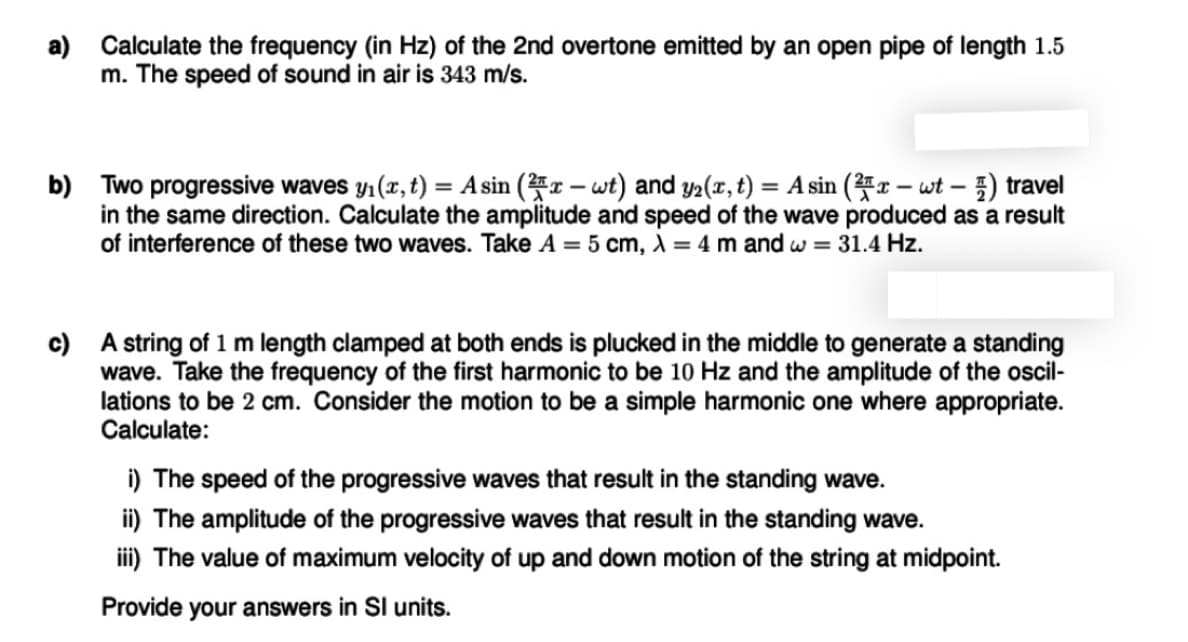b) Two progressive waves y1(x, t) = Asin (x – wt) and y2(x, t) = A sin (x – wt – ) travel in the same direction. Calculate the amplitude and speed of the wave produced as a result of interference of these two waves. Take A = 5 cm, ) = 4 m and w = 31.4 Hz. %3D
b) Two progressive waves y1(x, t) = Asin (x – wt) and y2(x, t) = A sin (x – wt – ) travel in the same direction. Calculate the amplitude and speed of the wave produced as a result of interference of these two waves. Take A = 5 cm, ) = 4 m and w = 31.4 Hz. %3D
Physics for Scientists and Engineers: Foundations and Connections
1st Edition
ISBN:9781133939146
Author:Katz, Debora M.
Publisher:Katz, Debora M.
Chapter18: Superposition And Standing Waves
Section: Chapter Questions
Problem 50PQ
Related questions
Question
Can you answer question b and all of question c

Transcribed Image Text:a) Calculate the frequency (in Hz) of the 2nd overtone emitted by an open pipe of length 1.5
m. The speed of sound in air is 343 m/s.
b) Two progressive waves y1 (x, t) = A sin (r – wt) and y2(x, t) = A sin (x – wt – ) travel
in the same direction. Calculate the amplitude and speed of the wave produced as a result
of interference of these two waves. Take A = 5 cm, ) = 4 m and w = 31.4 Hz.
c) A string of 1 m length clamped at both ends is plucked in the middle to generate a standing
wave. Take the frequency of the first harmonic to be 10 Hz and the amplitude of the oscil-
lations to be 2 cm. Consider the motion to be a simple harmonic one where appropriate.
Calculate:
i) The speed of the progressive waves that result in the standing wave.
ii) The amplitude of the progressive waves that result in the standing wave.
ii) The value of maximum velocity of up and down motion of the string at midpoint.
Provide your answers in SI units.
Expert Solution
This question has been solved!
Explore an expertly crafted, step-by-step solution for a thorough understanding of key concepts.
Step by step
Solved in 4 steps

Knowledge Booster
Learn more about
Need a deep-dive on the concept behind this application? Look no further. Learn more about this topic, physics and related others by exploring similar questions and additional content below.Recommended textbooks for you

Physics for Scientists and Engineers: Foundations…
Physics
ISBN:
9781133939146
Author:
Katz, Debora M.
Publisher:
Cengage Learning

Principles of Physics: A Calculus-Based Text
Physics
ISBN:
9781133104261
Author:
Raymond A. Serway, John W. Jewett
Publisher:
Cengage Learning

Physics for Scientists and Engineers, Technology …
Physics
ISBN:
9781305116399
Author:
Raymond A. Serway, John W. Jewett
Publisher:
Cengage Learning

Physics for Scientists and Engineers: Foundations…
Physics
ISBN:
9781133939146
Author:
Katz, Debora M.
Publisher:
Cengage Learning

Principles of Physics: A Calculus-Based Text
Physics
ISBN:
9781133104261
Author:
Raymond A. Serway, John W. Jewett
Publisher:
Cengage Learning

Physics for Scientists and Engineers, Technology …
Physics
ISBN:
9781305116399
Author:
Raymond A. Serway, John W. Jewett
Publisher:
Cengage Learning

University Physics Volume 1
Physics
ISBN:
9781938168277
Author:
William Moebs, Samuel J. Ling, Jeff Sanny
Publisher:
OpenStax - Rice University

College Physics
Physics
ISBN:
9781285737027
Author:
Raymond A. Serway, Chris Vuille
Publisher:
Cengage Learning

College Physics
Physics
ISBN:
9781938168000
Author:
Paul Peter Urone, Roger Hinrichs
Publisher:
OpenStax College